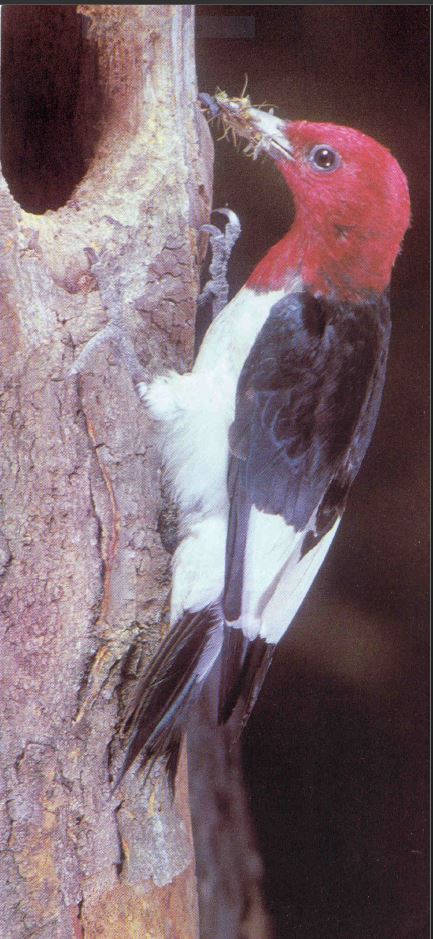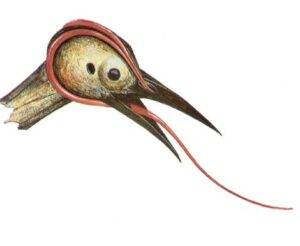YAHWEH’S CREATION OR RANDOM EVOLUTION?
Woodpeckers have some of the most remarkable habits of all living things. They are another amazing example of highly specialised creatures who obtain their food in a very unusual manner. They peck at trees to uncover grubs and ant colonies within the trunks.

PICKING UP PECKING GRADUALLY?
Could woodpeckers have ‘evolved’ gradually, learning to ‘survive’ in the only way possible for them, pecking deep into tough trees?
There are one hundred seventy-nine different species of woodpeckers in the world. They range in size from the huge Pileated (crested) Woodpecker (19 inches from tip of tail to tip of beak) to the tiny Downy. Each species finds its food in a slightly different fashion and feeds on different things.
The little Downy feeds on caterpillars found on small twigs and tiny crevices, while the Redheaded Woodpecker feeds on ants and grubs inside trees. The gaudily decorated Pileated Woodpecker can remove 30 feet of bark from a tree in less than 15 minutes preventing attacks by carpenter ants and the spreading of said ants to other healthy trees nearby.
The Flicker Woodpecker (named because of the flash of white colour on its wings in flight) feeds on or near the ground, lapping up ants with its sticky tongue.
UNUSUAL ANATOMY
First and most obvious is its beak. It is straight, very hard in comparison with most birds, and pointed. The head is constructed differently, too. The skull is much thicker than that of other birds, and the skull and beak are moved (sometimes more than a hundred times a minute) by powerful muscles. The bones between the the beak and skull have their own ‘shock absorbers’, being constructed differently than those of other birds, which are directly joined together. In the woodpecker family, the beak and skull are joined by connective tissue that is spongy and elastic.
Every part of the woodpecker anatomy is specially constructed for the sole purpose of drilling into wood. Their claws are divided into two sharp and powerful toes forward and two backward, like a pair of ice tongs, for gripping the bark. Their tail feathers act as a brace, steadying the bird on a firm tripod as it whacks away. The tail feathers are unusually strong, and during moulting season, the main propping feathers do not fall out until other feathers have already been replaced, and can support the weight of the bird while the bigger stronger feathers moult.
HOW THEY LOCATE THEIR FOOD
Once, a Pileated Woodpecker was observed whacking away on a tough old hickory. Ants were using a little knothole an entrance into the tree but the bird ignored the knothole. Instead, it began pounding on the trunk as it slowly circled the tree, tapping, then pausing. Then it drilled its way into the very heart of the ant nest, five feet below the knothole the ants were using.
Ornithologists speculate the woodpeckers use their acute sense of hearing (another remarkable part of their anatomical structure) to locate insects either by hearing them, or detecting the subtle differences in the sounds of the wood over insect channels, or both.
The woodpeckers tongue is perhaps it most remarkable instrument. In most cases, it is barbed, and about four times a s long as the beak. The woodpecker moves its tongue in and out in a manner similar to that of a snake’s tongue. In some species, the tongue is coated with a sticky substance, used as bait to catch ants. A woodpecker will drill into a tree, then snake out its long, sticky tongue, waiting until the ants believing it to be a worm invader, swarm all over it. The woodpecker then whips the unsuspecting ants into its mouth.

UNUSUAL STUDIES
Three woodpeckers were being studied in a cage by ornithologists when they decided to attempt an experiment. They tried holding food above and behind the birds’ heads, and were astonished when they whipped their tongues up over their heads, snatching away the food, without looking around, or turning their heads!
SUMMARY OF CHARACTERISTICS
● A powerful, heavy duty BEAK – perfect as a wood-boring tool.
● Tough NECK MUSCLES, necessary to deliver staccato, ‘jack-hammer’ blows with its beak.
● A THICK SKULL, made flexible by tiny cross braces.
● SHOCK ABSORBERS of heavy tissue between beak and skull – not found in other birds.
● A long slender TONGUE, generally barbed and covered with a sticky substance to ‘fish out’ insects.
● Shorts, powerful LEGS unlike spindly legs of most birds.
● Viselike TOES, two in front and two in the back – a perfect pincer for grasping bark.
● Stiff TAIL FEATHERS that end in sharp spines. These are essential to prop up the woodpecker as it excavates its nesting site
Could all EIGHT of these specialised parts evolve at once? Impossible!
Mutations cannot explain away the woodpecker. Vague ideas about birds cleaning their beaks on limbs, and just accidentally beginning to peck lightly on trees will not explain it. Millions of woodpeckers around the world have poked holes in the theory of evolution.
Source:
Jerry Gentry, Garner Ted Armstrong and Paul W Kroll – from ‘A Theory for the Birds
(Copyright © 1967, 1968, 1971 Ambassador College Press, Pasadena, California, USA)